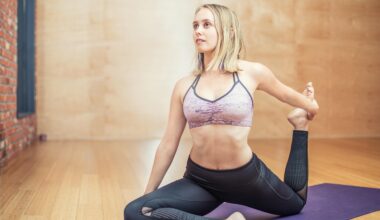Using Functional Training to Enhance Trail Running Strength
Trail running is an exhilarating activity that combines fitness with nature and provides a unique challenge. To excel in this sport, runners must possess a blend of strength, endurance, and agility. Functional training is ideal for enhancing these attributes, as it focuses on movements that mimic the demands of daily activities. This type of training helps improve muscle coordination, balance, and flexibility, which are crucial for tackling uneven terrains and steep elevations. Furthermore, incorporating exercises like squats and lunges can enhance leg strength. When these exercises are performed with proper technique, they improve overall performance and reduce injury risk. Runners often overlook the significance of strength training, thinking that endurance alone is enough. However, building strength in stabilizing muscles can lead to improved running efficiency. Incorporating various movement patterns engages multiple muscle groups and reinforces muscular endurance. Additionally, functional training programs can be tailored specifically for trail running athletes, ensuring that focus remains on developing the skills needed for this adventurous sport. In the following sections, we will delve into specific exercises and methodologies to enhance your trail running through functional training.
Key Benefits of Functional Training
Functional training offers a plethora of benefits specifically advantageous for trail runners. First and foremost, it enhances core strength, which is vital for maintaining stability during your runs. A strong core supports proper posture, directly impacting running form and efficiency. Moreover, engaging in functional exercises helps improve joint stability, reducing the chance of injuries that can arise from uneven surfaces. This training modality also fosters flexibility, allowing trail runners to navigate technical terrains with greater ease. Additionally, functional training improves proprioception, which is the body’s ability to detect its position in space. Increased proprioception can significantly enhance your coordination, balance, and agility, critical attributes for trail runners. By varying the types of movements and activities involved in training, runners can also maintain motivation and interest in their workouts. Functional training reduces monotony and keeps routines fresh and engaging. Furthermore, workouts can be easily modified to accommodate different fitness levels, making them accessible to every runner. Whether you are a beginner aiming to build a solid foundation or a seasoned athlete seeking to refine your skills, functional training can offer immense value, drastically elevating your performance.
One of the primary goals of functional training is to develop strength through a variety of movements. This expansive approach is in stark contrast to traditional weightlifting, which often isolates specific muscles. Instead, functional exercises engage multiple muscles simultaneously, reflecting real-world challenges faced during trail running. Activities such as pushing, pulling, twisting, and squatting feature prominently, resulting in better functional strength. For example, performing a kettlebell swing targets muscles like the glutes, back, and legs simultaneously, promoting effective and dynamic performance on trails. Furthermore, incorporating equipment like resistance bands or stability balls can differentiate and diversify workouts. Enhancing strength through integrated movements gives runners an edge by enabling them to power through tough terrains without fatigue. Additionally, functional strength training prepares the body for the gradual transitions in elevation experienced while trail running. Runners must adapt along varied ascents and descents, making strength, balance, and agility crucial to remain injury-free. Strengthened muscles produce the necessary power for uphill climbing while maintaining control during rapid descents. Ultimately, a robust and functional body is liberated from excessive wear and tear, allowing athletes to enjoy their sport to the fullest.
Effective Functional Exercises for Trail Runners
When considering effective functional exercises for trail running, specific movements stand out for their efficacy. One excellent exercise is the single-leg deadlift, which builds balance and strengthens the posterior chain. This exercise mimics the stability needed when traversing hills or rocky paths. Similarly, the Bulgarian split squat engages the legs and core while enhancing balance, making it ideal for runners. Another pivotal movement includes the lateral lunge, which emphasizes strengthening the adductor muscles—essential for trail runners who frequently change direction. Furthermore, incorporating multi-directional hops can boost agility and speed on trails, allowing for swift adjustments when needed. Plyometric box jumps are also invaluable for developing explosive power, which is helpful for sprinting up inclines. To focus on core strength, consider planks with rotation, enhancing stability while engaging several muscle groups. Lastly, bear crawls encourage full-body engagement, improving coordination and mobility. Varied workout routines can heighten training effectiveness while keeping individuals engaged. By combining strength, stability, and mobility exercises, runners can create a comprehensive conditioning program, honing the specific skills necessary to navigate trails confidently. These exercises not only enhance strength but significantly lower injury risk.
With trail running often leading to solitary pursuits, it is essential to cultivate a supportive training environment. One excellent way to achieve this is by participating in group functional training sessions for trail runners. These groups allow individuals to share experiences and tips while motivating each other to push their boundaries. Working alongside like-minded runners provides a greater sense of accountability, encouraging consistency in pursuing fitness goals. Furthermore, practicing with others can enlighten participants on different training techniques and approaches tailored to trail running. Additionally, attending workshops or clinics hosted by professional trainers can elevate participants’ understanding of functional training principles. Engaging with a coach helps runners refine their techniques and optimize their workouts. Incorporating team-focused activities strengthens camaraderie and fuels motivation on challenging training days. When training together, runners can incorporate competition or friendly challenges, enhancing commitment to sessions. Ultimately, trail running’s social aspect adds enjoyment while building essential strength. Combining individual goals with group activities can create a balanced training platform, balancing personal growth and community engagement. These connections can foster lasting friendships that positively influence performance and promote injury-free pursuit of trail running adventures.
Incorporating Functional Training into Your Routine
Incorporating functional training into your existing trail running routine requires thoughtful planning and strategy. Begin by assessing your current fitness level and specific goals, determining which areas require improvement. For example, if lower body strength is lacking, prioritize exercises targeting these muscles to enhance uphill running performance. Schedule workouts strategically in your weekly training plan, ensuring proper recovery time between sessions. Short functional training sessions, lasting 30–45 minutes, can be effectively added to days when running intensity is lower. Focus on quality over quantity, emphasizing correct form and technique while maintaining an adequate level of challenge. It’s advisable to start with 2-3 functional training sessions per week and gradually increase as your body adapts. Incorporate a mix of exercises addressing core, upper body, and lower body strength for well-rounded development. Additionally, monitoring progress through journaling or fitness apps allows for valuable insights into improvement over time. Lastly, listening to your body during this process is vital; adequate rest is crucial, especially after intense workouts. Allow for adjustment periods as you blend functional training with trail running, obtaining the benefits without compromising your running routine or risk of injury.
The intersection of functional training and trail running ultimately leads to an exciting fitness journey worth pursuing. By precisely targeting strength, stability, and agility, runners can significantly enhance their performance on the trails while minimizing injury risk. Achieving a personalized functional training setup will help craft a regimen that meets individual needs and preferences. Stay encouraged by the progress you witness as you incorporate these exercises into your routine. Consider connecting with others who share similar goals to nurture a supportive community. Regularly re-evaluating accomplishments and experiences can maintain enthusiasm and motivation along the path toward achieving athletic milestones. Embrace the challenges offered by trail running and functional training as they provide unique opportunities for growth. By committing time and effort to this combination, athletes unlock further athletic potential, leading to a more rewarding outdoor experience. Additionally, sharing knowledge with peers and learning from others can further enrich this training journey. Whether you’re ascending steep hills or navigating technical descents, functional training can undoubtedly empower you to tackle those challenges head-on. Ultimately, the synergy of functional training and trail running leads to breakthroughs in endurance, strength, and the pure joy of trail exploration.
Conclusion: Elevate Your Trail Running
In conclusion, blending functional training into trail running is an effective strategy to enhance overall performance. Strength, stability, and agility are pivotal qualities for any trail runner navigating rugged terrains. As you embark on this transformative journey, reinforce your commitment to health and fitness. Explore different functional exercises that resonate with you, adapting them into a balanced workout routine. Remember, consistency and patience are vital for achieving maximum results and improving your skills. Regularly engaging in these functional exercises not only supports running performance but also fosters a sustainable fitness lifestyle. As you progress, celebrate your accomplishments and set new goals to maintain motivation. There is a wealth of resources available, including printable workout plans and online classes to further enhance your functional training knowledge. Incorporating variety keeps your workouts exciting and effective. Therefore, challenge yourself to continually evolve and grow as a runner. By committing to this integrated approach, every run will become a stepping stone towards a stronger, more capable trail runner. Experience the exhilarating feeling of personal growth and accomplishment as you conquer new trails with confidence and strength.


